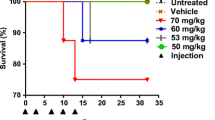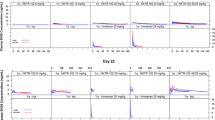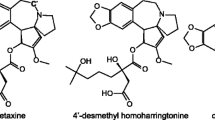Abstract
Purpose: Dolastatin 10 (DOL 10), an oligopeptide isolated from the sea hare Dolabella auricularia, has been shown to be a highly potent cytotoxic agent in a variety of human tumor cell lines. The purpose of this study was to conduct preclinical toxicity evaluations to determine the target organ(s) of toxicity and its reversibility, the dose-limiting toxicity and the maximum tolerated dose (MTD), and to use this information for arriving at a safe starting dose and dose schedule for phase I clinical trails. Methods: DOL10 was administered as a single intravenous bolus dose to CD2F1 mice, Fischer-344 rats and beagle dogs. Endpoints evaluated included clinical observations, body weights, hematology, serum clinical chemistry, and microscopic pathology of tissues. Results: The MTD (i.e. the highest dose that did not cause lethality but produced substantial toxicity) was approximately 1350 μg/m2 body surface area (450 μg/kg) in mice, 450 μg/m2 (75 μg/kg) in rats and ≤400 μg/m2 (≤20 μg/kg) in dogs. Adverse signs were observed at doses ≥1350 μg/m2 in mice, ≥150 μg/m2 in rats and ≥400 μg/m2 in dogs. Decreased weight gain or actual weight loss was observed at doses ≥1350 μg/m2 in mice, ≥600 μg/m2 in rats and ≥450 μg/m2 in dogs. In all three species, the primary target organ of toxicity was the bone marrow, as indicated by decreases in the numbers of erythroid cells, myeloid cells, and megakaryocytes in the femoral bone marrow and by decreased white blood cell (WBC) and reticulocyte counts in peripheral blood. Marked neutropenia (i.e. >50% decrease compared to control animal or baseline values) was the principal effect on WBCs and occurred within a week of dosing. A mild anemia was evident 1 week after administering the drug to rats and dogs. The hematologic effects were transient and reversed by study termination. Other lesions at the MTD levels were cellular depletion and necrosis in lymphoid organs (rats and dogs), marked depletion of extramedullary hematopoietic cellular elements in the spleen (rats), thymic atrophy (mice and dogs), and minimal cellular necrosis in the ileum (rats). More extensive and severe pathology was observed in animals sacrificed in a moribund condition or found dead. Conclusions: Myelotoxicity was dose-limiting in all three species with mice being the least sensitive. In a phase I clinical trial, granulocytopenia was dose-limiting. Moreover, the MTD of DOL10 for rats and dogs is comparable to the human MTD. Therefore, the results from the preclinical toxicology studies correctly predicted a safe starting dose, the dose-limiting toxicity, and the MTD in humans.
Similar content being viewed by others
Author information
Authors and Affiliations
Additional information
Received: 20 May 1998 / Accepted: 11 February 1999
Rights and permissions
About this article
Cite this article
Mirsalis, J., Schindler-Horvat, J., Hill, J. et al. Toxicity of dolastatin 10 in mice, rats and dogs and its clinical relevance. Cancer Chemother Pharmacol 44, 395–402 (1999). https://doi.org/10.1007/s002800050995
Issue Date:
DOI: https://doi.org/10.1007/s002800050995




